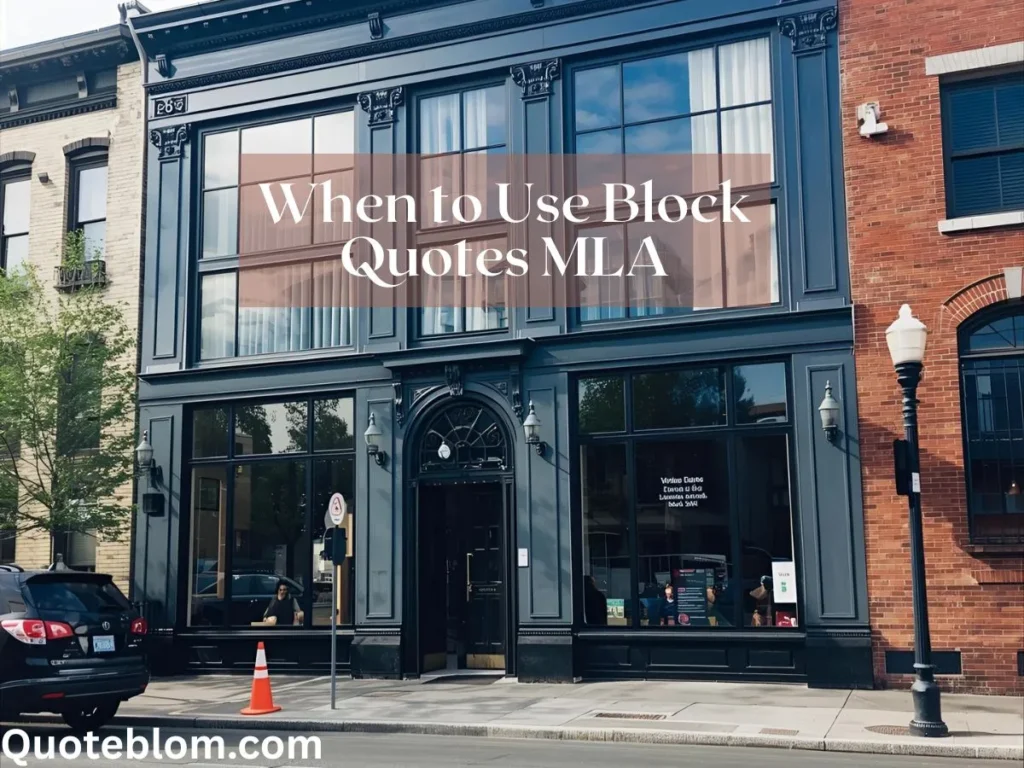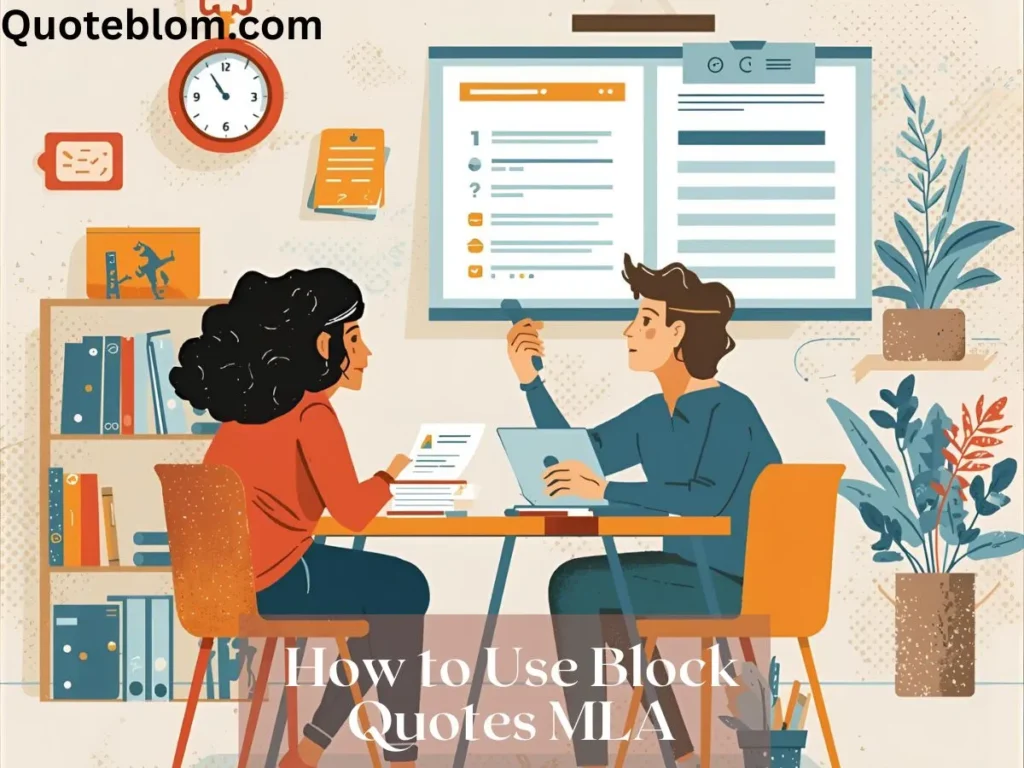Struggling to format long quotes in your academic paper?
Understanding block quotes in MLA style can help you stay organized and meet citation standards with ease.
If you’re quoting dialogue from a novel, citing evidence for your thesis, or referencing a critical source, proper MLA block quote formatting ensures clarity and academic integrity.
This guide will walk you through everything—from when to use block quotes to formatting, citing, and even giving examples.
With our step-by-step breakdown and quote examples, you’ll master MLA block quotes without stress.
Let’s turn confusion into confidence!
How to Do Block Quotes MLA

📚 Use a colon to introduce the quote
✏️ Start the block quote on a new line
📝 Indent the entire quote one inch from the left
📖 Do not add quotation marks around the block quote
📄 Maintain double-spacing throughout
🔍 Ensure the quote is longer than four lines of prose
📘 Use the author’s exact words without changes
🖋️ Place the parenthetical citation after the period
🗂️ Introduce the quote with a complete sentence
📌 Avoid unnecessary formatting like bold or italics
📎 Only use when the quote is essential
📅 Always follow MLA 9th edition guidelines
📈 Don’t interrupt the flow of your own writing
🔗 Provide context before and after the quote
🧾 Make sure the block quote enhances your argument
How to Format Block Quotes MLA
📏 Indent the entire block quote one inch from the margin
✒️ Use double-spacing throughout the quote
🧷 Do not use quotation marks
🗃️ Use a colon to introduce the quote if preceded by a full sentence
🧾 Include the citation after the final punctuation mark
📄 Maintain the font and size used in the rest of your paper
🖋️ Start the block quote on a new line
🧱 Avoid using multiple block quotes back to back
📜 Only include necessary punctuation
📘 Cite the source correctly based on MLA rules
📐 Keep the original formatting of poetry or dialogue
📚 Place a period before the in-text citation
📊 Do not right-align or center the text
✍️ Limit the use of block quotes to avoid overwhelming the paper
📎 Include analysis before or after the quote
When to Use Block Quotes MLA

⏳ When quoting more than four lines of prose
🧠 When analyzing lengthy passages from literature
📘 When citing long pieces of dialogue
📚 When a quote needs its own space for clarity
🗨️ When the quote supports your thesis significantly
🧾 When keeping the quote’s structure is crucial
📖 When quoting multiple speakers in a play
📄 When visual formatting of the quote matters
📈 When summarizing would weaken the source’s impact
🧵 When discussing themes directly from the source
📝 When it’s a key piece of evidence
📌 When paraphrasing isn’t sufficient
🔍 When the original wording carries weight
📅 When academic guidelines specifically ask for it
🖋️ When using historical or critical text excerpts
Block Quotes MLA Format
📏 One-inch indentation on the left
🧾 No quotation marks
📄 Double-spacing only
🖋️ Place citation after punctuation
✍️ Introduce with a complete sentence
📘 Consistent font and size
📚 Avoid bold or italic unless in original text
📎 Use when quote exceeds four lines
📐 Maintain original line breaks for poetry
🧠 Keep punctuation intact from the original
🧵 Place period before citation
📌 Don’t mix with other formatting styles
📈 Use sparingly for best effect
📖 Insert commentary before/after quote
🗂️ Centered title and left-aligned block text
How to Cite Block Quotes MLA
📚 Cite with author’s last name and page number
🖋️ Example: (Smith 123)
📘 Citation comes after the final punctuation
📝 No comma between name and page number
📄 Use the full citation in the Works Cited page
📌 Maintain punctuation from original text
📖 No quotation marks around the citation
🗂️ Keep citation consistent with MLA 9th edition
📎 Parenthetical citation at the end of the block quote
🧾 Do not italicize the citation
📏 Place one space before the citation
🧠 Always cite even if you paraphrase
🧵 Mention author in signal phrase if needed
📈 Avoid ambiguous references
📅 Include edition if necessary in Works Cited
How to Use Block Quotes MLA

🧠 Use only when necessary and impactful
📚 Always provide context
🖋️ Don’t let the quote stand alone
📘 Analyze after quoting
🧾 Keep block quotes brief and relevant
📄 Format carefully to match MLA style
📌 Introduce with a strong lead-in sentence
🗂️ Avoid overuse in short essays
🧱 Match the quote’s tone with your argument
📈 Use to add credibility
✍️ Be selective—use only the most compelling sections
🧵 Highlight your interpretation of the quote
📎 Blend the quote smoothly into your analysis
📏 Maintain visual clarity with spacing
📅 Keep reader’s focus on your thesis
Formatting Block Quotes MLA
📏 Indent entire quote one inch
📄 Do not use quotation marks
🖋️ Maintain double-spacing
📘 Follow font and size guidelines
📎 Begin on a new line
🧾 Add citation after punctuation
🧠 Keep source’s punctuation intact
📚 Use consistent MLA 9 formatting
🗂️ Avoid decorative formatting
✍️ Stick to Times New Roman, 12 pt.
📌 Do not add extra spaces before or after
📖 Maintain line breaks for poetry
📈 Align quote to left margin only
📅 Include proper heading and page numbers
🧵 Don’t combine with block quotes from different sources
When to Do Block Quotes MLA
📚 When quote exceeds four lines
📘 When quote is essential for understanding
🖋️ When structure matters (e.g., poetry or dialogue)
📄 When you’re citing plays or scripts
🧾 When quote forms the core of your analysis
📌 When paraphrasing would dilute meaning
🧠 When original phrasing is powerful
🧵 When source’s formatting is integral
📈 When directed by your instructor
📎 When quoting multiple lines from one source
🗂️ When the reader needs to see exact wording
📖 When comparison with another text is needed
📅 When required by the assignment guidelines
✍️ When your argument directly builds on the quote
📏 When clarity and readability are improved
Block Quotes MLA Example

📘 In To Kill a Mockingbird, Harper Lee describes:
“People generally see what they look for, and hear what they listen for.
They don’t bother to understand each other…” (Lee 118).
🖋️ Example from a play:
HAMLET:
To be, or not to be: that is the question:
Whether ’tis nobler in the mind to suffer
The slings and arrows of outrageous fortune…” (Shakespeare 3.1.56–60).
📄 Example of poetry block quote:
Because I could not stop for Death –
He kindly stopped for me –
The Carriage held but just Ourselves –
And Immortality. (Dickinson lines 1–4)
📌 Historical document quote:
“We hold these truths to be self-evident,
that all men are created equal…” (Jefferson).
📎 Academic reference:
“Education is not the filling of a pail,
but the lighting of a fire.” (Yeats)
📚 Critical theory example:
“The medium is the message.” (McLuhan 7)
📖 Classic novel excerpt:
“It was the best of times, it was the worst of times…” (Dickens 1)
🧵 Modern literature quote:
“So it goes.” (Vonnegut 44)
🧾 Psychological text:
“Man is not worried by real problems
so much as by his imagined anxieties…” (Seneca)
📄 Scientific text excerpt:
“In the beginning there was nothing,
which exploded.” (Terry Pratchett)
📘 Motivational speech:
“Ask not what your country can do for you—
ask what you can do for your country.” (Kennedy)
📈 Philosophy reference:
“I think, therefore I am.” (Descartes)
🧠 Literature analysis:
“All animals are equal,
but some animals are more equal than others.” (Orwell 112)
📖 Cultural criticism:
“A people without the knowledge of their past history,
origin and culture is like a tree without roots.” (Garvey)
Conclusion
Mastering MLA block quotes is essential for any student or academic writer.
With correct formatting, thoughtful usage, and precise citation, block quotes can elevate your argument and enhance your writing.
Remember, it’s not just about quoting—it’s about using the quote purposefully and presenting it professionally.
Use them wisely and your paper will shine with clarity and authority.




